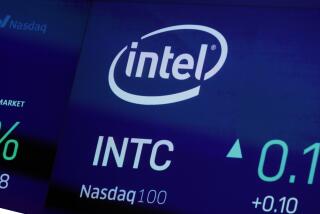NEWS ANALYSIS : A Pyrrhic Victory for Intel, AMD : Case Cost Chip Makers Dearly but Won’t Stop Others
- Share via
SAN FRANCISCO — The Gargantuan legal battle between chip makers Intel Corp. and Advanced Micro Devices Inc. cost more than $100 million, consumed thousands of hours of executives’ time, burned out at least one general counsel and wrecked a collegial Silicon Valley friendship--and it ended Wednesday with a modest net payment of $40 million.
Was it worth it? Hardly. Will such fiascoes be repeated in the litigious high-tech industry? Almost certainly.
There was plenty of pious talk Thursday about the horrors of lawsuits, about how “nobody won” in the seven-year struggle, about how, in the words of Intel general counsel Tom Dunlap, “we’d rather put our money into paying engineers . . . than lawyers.”
And yet, all across the high-tech industry, companies obviously believe that in many situations, fighting in court can be good business. Copyright lawsuits are rampant in the software business. Compaq Computer, a staunch critic of Intel’s aggressive tactics in the microprocessor business, has itself filed a patent infringement suit against Packard Bell.
About the only clear lesson anyone seemed to be taking Thursday was to be cautious about the wording of technology-sharing contracts, the better to stay out of court--or to win if you land there.
“This is a lesson for us to be concerned about what intellectual property rights we give to others,” said James Pooley, a lawyer in nearby Menlo Park. “You can’t be clairvoyant about the industry, but you can be careful.”
Back in 1976, when AMD and Intel first signed a technology-sharing agreement, few would have predicted just how valuable Intel’s microprocessor technology would become. The personal computer, as we know it today, had yet to be invented. And Intel was not the only company to have developed a microprocessor, the heart of the PC: AMD had one too.
When IBM adopted Intel’s chip for its first PC, Intel decided that the deal--in which the two companies traded part for part--was no longer a fair one. The Intel microprocessor was far more valuable than anything AMD could give it in return. But AMD countered that a deal is a deal. “It’s hard for an outsider to know who was right and who was wrong,” said Safi Qureshey, chief executive of AST Research, an Irvine PC maker.
And so, in 1987, began a tangle of litigation, first an arbitration proceeding over the original contract (which had been renewed in 1982) and later lawsuits filed by Intel over clone chips AMD had developed itself.
Engineers from both companies spent hours in depositions rather than working on product design. AMD Chief Executive W.J. (Jerry) Sanders III spent two months sitting at the defense table in a courtroom. At the end of a long day of listening to testimony, he would rush back to the office to attend to company business. “I was putting in 18-hour days,” Sanders recalled.
Retired Judge J. Barton Phelps, who spent an almost unheard-of 4 1/2 years arbitrating a key aspect of the battle, acknowledged that most laypersons might view the whole episode as a big waste of time and money. He maintained, however, that the issues were complex and deserved to be aired.
“It was so complicated that the parties had to have a forum in which to ventilate their differences,” he said. “It would have taken far longer in court.”
Has the experience helped to mellow Intel, a notorious litigator which has used lawsuits as a weapon whenever the opportunity has presented itself?
The company has now resolved most of its outstanding high-profile cases against its rivals, including Cyrix and ULSI.
Battered by a public relations fiasco over a flaw in the Pentium computer chip and more vulnerable than ever to competitors, Intel may have decided that its go-for-the-jugular business philosophy--so evident in the courtroom--was doing more harm than good.
Dunlap denies that is the case. But employees speak privately about being sick of the whole matter.
For AMD, the settlement terms announced Wednesday free it of an albatross of litigation that had threatened at times to saddle the Sunnyvale chip maker with hefty damage payments to Intel. AMD agreed to pay Intel $58 million--instead of the $1 billion Intel had sought--and to limit the number of its 486 clones to be made by outside foundries. (Intel will pay AMD a mere $18 million, a pittance compared to the more than $2 billion AMD had gone after.)
AMD also received a perpetual license to the microcode of Intel’s 386 and 486 chips. It agreed not to copy any other Intel microcode, including that used in the Pentium chip. (The 386 has been largely eclipsed by technology improvements, though 486 clones such as AMD’s are still highly profitable. But the market is moving quickly to more powerful chips such as the Pentium.)
To reflect the settlement charges, AMD on Thursday restated its 1994 earnings, reducing its net income by about $36 million--to $305 million.
Pleased as Sanders is with the settlement, the resolution came as something of a pyrrhic victory.
“We’d probably be a $3-billion company rather than a $2-billion company” if it weren’t for the legal tussle, he said.
With the litigation hanging over its head, lenders were reluctant to finance the construction of new fabrication plants.
“This was something (my colleagues and) I lived with day and night,” said AMD general counsel Thomas Armstrong, 54, whose stressful experience contributed to his decision to resign last spring. “I’d wake up at 4. I’d lie awake in bed, terrified. To paraphrase Napoleon, no man is a hero at 4 in the morning.”
*
More Computer News
* The TimesLink on-line service includes a large selection of other recent articles and information about Computers & Technology in its Business section.
Details on Times electronic services, A4







